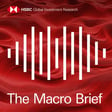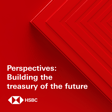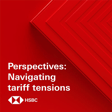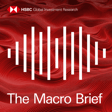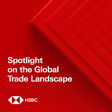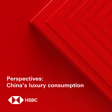Become a Creator today!Start creating today - Share your story with the world!
Start for free
00:00:00
00:00:01

The Macro Viewpoint -- India’s digital drive, mixed global signals and a 12th UK rate rise
Pranjul Bhandari discusses how tech-focused sectors can power India’s growth, Harriet Smith charts the latest data on the global economy and Liz Martins assesses what’s next in UK monetary policy as borrowing costs approach a 15-year high.
Disclaimer: https://www.research.hsbc.com/R/51/DgBxsnV Stay connected and access free to view reports and videos from HSBC Global Research follow us on LinkedIn https://www.linkedin.com/feed/hashtag/hsbcresearch/ or click here: https://www.gbm.hsbc.com/insights/global-research.
Hosted on Acast. See acast.com/privacy for more information.
Transcript
Introduction to HSBC Podcast Series
00:00:02
Speaker
Welcome to HSBC Global Viewpoint, the podcast series that brings together business leaders and industry experts to explore the latest global insights, trends, and opportunities.
00:00:13
Speaker
Make sure you're subscribed to stay up to date with new episodes.
00:00:16
Speaker
Thanks for listening.
00:00:17
Speaker
And now onto today's show.
00:00:24
Speaker
The following podcast was recorded for publication by HSBC Global Research.
00:00:28
Speaker
All the disclosures and disclaimers associated with it must be viewed on the link attached to your media player.
India's Tech Sector and Economic Growth
00:00:39
Speaker
Hello, I'm Piers Butler in London.
00:00:41
Speaker
And I'm Aline Van Dyne in New York.
00:00:44
Speaker
Coming up on today's programme, we assess the potential for tech-focused sectors to power Indian growth in the next decade.
00:00:51
Speaker
We find out why there's good news and bad news when it comes to the global economy.
00:00:56
Speaker
And we assess the UK's tightening cycle with interest rates now at their highest level since 2008.
00:01:03
Speaker
We begin this week in India, where tech and digital industries are playing a more important role than ever and helping to drive the country's growth.
00:01:11
Speaker
But can they provide enough new jobs for a booming population?
00:01:15
Speaker
Pranjal Bhandari, Chief India Economist, is here to discuss.
00:01:19
Speaker
Pranjal, welcome to the podcast.
00:01:21
Speaker
Great to be here, Piers.
00:01:22
Speaker
Well, and I must say it's really great to get an economist on the podcast that's talking a sort of positive story.
00:01:28
Speaker
And we've had a lot of gloom and doom.
00:01:30
Speaker
So it's really nice to see this report that you've just published.
00:01:33
Speaker
And in this report, you talk about India's new growth drivers.
00:01:37
Speaker
So maybe let's kick off with that and tell us about what they are.
00:01:40
Speaker
Yeah,
Post-Pandemic Growth in India's High-Tech Exports
00:01:41
Speaker
sure.
00:01:41
Speaker
So a small part of India, which we call New India and which comprises of high-tech sectors, is growing rapidly and is raising growth.
00:01:50
Speaker
So now these high-tech sectors, they're basically made of two parts.
00:01:54
Speaker
One is India's high-tech exports.
00:01:56
Speaker
Now it's not just the exports of goods, but even more importantly, it's the exports of services.
00:02:03
Speaker
India today is not just exporting IT services, but it's also exporting R&D services, design services, professional consulting services.
00:02:12
Speaker
And this is one area which has really taken off after the pandemic.
00:02:16
Speaker
And then of course there's high-tech goods too.
00:02:18
Speaker
For instance, India is gaining global market share in the exports of mobile handsets, drugs and pharmaceutical products, automobile parts.
00:02:27
Speaker
The other part of the new India is the startup ecosystem.
00:02:32
Speaker
India has a digital infrastructure and a lot of small startups have plugged into that and are providing real economy solutions to a lot of problems.
00:02:41
Speaker
So give us a sense of scale.
00:02:43
Speaker
I mean, in your report, you talk about the fact that these growth drivers could help the size of the economy more than double over the next
GDP Growth and Economic Reforms in India
00:02:52
Speaker
10 years.
00:02:52
Speaker
Yeah, that's right.
00:02:53
Speaker
So on the eve of the pandemic, India's overall GDP growth was 6%.
00:02:58
Speaker
And on the back of new India, we think it could be 6.5% over the next 10 years.
00:03:03
Speaker
Now with this, the India's economy size
00:03:07
Speaker
would double from about $3.5 trillion now to around $7.5 trillion in the next 10 years.
00:03:14
Speaker
And I think that's quite impressive because that would make India the third largest economy in the world right after the US and China.
00:03:23
Speaker
It would also help the Indian economy graduate from a lower middle income country to an upper middle income country.
00:03:29
Speaker
Now, importantly, in order to achieve this positive scenario, there are some important conditions to be met.
00:03:37
Speaker
Can you summarize what those are?
00:03:39
Speaker
Yes, absolutely.
00:03:40
Speaker
Some very important conditions have to be met.
00:03:42
Speaker
I think the first one is a continuous flow of reforms.
00:03:46
Speaker
We've had a lot of reforms in the last couple of years.
00:03:49
Speaker
For example, the goods and services tax reform, a new digital infrastructure.
00:03:54
Speaker
But we shouldn't get complacent with just that.
00:03:57
Speaker
We need a new wave of reforms.
00:03:59
Speaker
from tax reforms to a new tariff structure, which is more trade-friendly, to power sector reforms, judicial reforms, and a climate change framework that can help India navigate in this very volatile period.
00:04:13
Speaker
Then we need private capex to rise as well.
00:04:16
Speaker
It's been sluggish over the last decade.
00:04:18
Speaker
Hopefully, things are getting better.
00:04:20
Speaker
Balance sheets are in a better place.
00:04:21
Speaker
So we see it go up.
00:04:23
Speaker
But it'll be very important that private sector capex really does rise.
00:04:27
Speaker
And then there's education reforms.
00:04:29
Speaker
You know, the education standards and employability standards have taken a setback in the pandemic period, and India really needs some corrective measures there.
00:04:38
Speaker
So all of these things have to go right for India to get to its high growth dreams.
00:04:43
Speaker
Now, doubling over the economy sounds just huge, but ironically, and this refers to some of the work you've done before, the population growth in India really requires a very significant amount of job creation.
00:04:58
Speaker
Is this growth that you're talking about going to be sufficient to address this need?
00:05:02
Speaker
Well, perhaps not.
00:05:03
Speaker
So, you know, you may know that this year, India has become the most populous country in the world.
00:05:10
Speaker
And our sense is that in the next decade, it needs to create 70 million new jobs.
00:05:16
Speaker
Now, a 6.5% growth clip over the next decade can only get us about a third of these jobs.
00:05:22
Speaker
And India will have to work for stronger and higher growth if it really wants to create more jobs.
00:05:28
Speaker
And our sense is that with a growth clip of around 7.5%, that would be possible.
00:05:34
Speaker
But how do you get to 7.5%?
Digital Infrastructure and Low-Tech Manufacturing
00:05:36
Speaker
And here my sense is that so far we've been talking about new India, all the high tech things, but we have to also have a way to pull up old India.
00:05:45
Speaker
Old India mostly comprises of some sluggish sectors, for instance, the low tech manufacturing, for instance, agriculture.
00:05:53
Speaker
If we can have a way in which new India can influence and energize old India, we could actually get to seven and a half percent growth and create two thirds of the jobs that we need.
00:06:04
Speaker
Thankfully for the first time, I do see a ray of hope.
00:06:07
Speaker
The whole digital infrastructure that we have right now can actually help startups provide a lot of solutions to low-tech manufacturing.
00:06:17
Speaker
For instance, pick up a bunch of low-tech manufacturing firms, provide them access to cheap inputs, to better export markets, to better credit access, and basically help small firms get the advantage of big firms by simulating scale.
00:06:33
Speaker
And I think if we can get that done,
00:06:34
Speaker
then we could hope for about a 7.5% growth too.
00:06:38
Speaker
Well, this sounds like a really exciting story.
00:06:39
Speaker
I'm sure we will have you back on the podcast to update us on it.
00:06:42
Speaker
But thank you for joining us today, Pranjal.
00:06:45
Speaker
Great to be here.
Global Economic Challenges and Central Bank Policies
00:06:50
Speaker
So Pranjal is optimistic about India's longer term growth prospects, but let's return to the here and now with a look at the latest global economic data, which paints a rather mixed picture.
00:07:02
Speaker
Harriet Smith from our economics team is here to tell us what she makes of it all.
00:07:07
Speaker
So Harriet, let's start with areas of weakness.
00:07:10
Speaker
The global manufacturing sector is having a bit of a rough time, isn't it?
00:07:15
Speaker
Yes, aside from a few exceptions, manufacturing activity across the board looks bleak.
00:07:21
Speaker
The global manufacturing PMI has been weak and remained in contractual territory in April as demand remained soft, particularly in Europe.
00:07:29
Speaker
Additionally, the slowdown in April was led by a downturn in manufacturing activity in mainland China as the impact of COVID-19 reopening faded.
00:07:38
Speaker
With goods demand soft, coupled with supply chain disruptions lessening, firms have seen their inventory levels build back.
00:07:45
Speaker
However, this is potentially good news from an inflationary point of view.
00:07:49
Speaker
This is putting down the pressure on goods prices and along with a moderation and input price inflation, job of goods inflation has started to come down in most economies.
00:07:58
Speaker
Interesting.
00:07:59
Speaker
In terms of the activity level, though, the picture is much stronger in the services side of the economy, right?
00:08:06
Speaker
That's right.
00:08:06
Speaker
While manufacturing activity stands weak in much of the world, the services side of the economy remains remarkably strong.
00:08:13
Speaker
This divergence is clear in the latest PMI data for April, where the global composite PMI increased for another month, driven by the services sector, which saw higher new orders and an expansion in output.
00:08:25
Speaker
As a result, with demand for services strong, supported by tight labour markets, price pressures on this side of the economy are not subsiding as policymakers may want them to.
00:08:35
Speaker
So unlike goods inflation, services inflation keeps grinding higher in several economies.
00:08:41
Speaker
So what do these mixed signals mean in terms of the policy outlook?
00:08:46
Speaker
So it does create a challenging backdrop for monetary policy decisions.
00:08:50
Speaker
Although we have seen some encouraging signs on input prices and the pricing surveys, inflation is too high and remains a big challenge for policymakers.
00:08:59
Speaker
There are plenty of risks to consider too.
00:09:02
Speaker
Higher rates are being felt in economies and banking sector risks need to be considered.
00:09:07
Speaker
So yes, there are a lot of mixed signals and it's a complicated picture.
00:09:11
Speaker
Harriet, thank you so much for the update.
00:09:16
Speaker
I'm Harold van der Linden.
00:09:17
Speaker
And I'm Fred Newman.
00:09:18
Speaker
And you can find us under the banyan tree.
00:09:20
Speaker
Join us weekly where we bring Asian markets and macroeconomics into context with special insight from our regional experts here at HSBC Global Research.
00:09:30
Speaker
Search for HSBC Global Viewpoint on Apple Podcasts or Spotify or join us via the HSBC Global Banking and Markets page on LinkedIn.
00:09:40
Speaker
Enjoy the rest of your podcasts and we'll see you under the banyan tree.
00:09:45
Speaker
We finish here in the UK where the Bank of England has raised bank rate by 25 basis points, taking it to 4.5%.
00:09:53
Speaker
So after 12 consecutive rate rises, is that the tightening cycle over with?
00:09:57
Speaker
Let's speak to Liz Martins, senior UK economist.
00:10:01
Speaker
Liz, welcome to the podcast.
00:10:02
Speaker
Thank you.
00:10:03
Speaker
So Liz, Bank of England decision very much as expected.
00:10:06
Speaker
No panic.
00:10:07
Speaker
Everything OK?
00:10:08
Speaker
Yeah, exactly.
00:10:09
Speaker
So we were expecting a 7-2 vote for a 25 basis point rate rise to 4.5% and that is exactly what we got.
00:10:15
Speaker
So two dissenters who wanted not to raise bank rate at all.
00:10:20
Speaker
But yeah, no panic.
00:10:21
Speaker
Even though we'd had, you know, that higher than expected inflation release, higher than expected wage growth, none of the hawks said they were overly worried or not to the point of voting for a bigger move anyway.
00:10:30
Speaker
So all very much in line with expectations.
00:10:33
Speaker
But interestingly, when you read into the detail, there are some pretty big revisions to their forecasts.
00:10:38
Speaker
Well, the biggest revision on record, in fact, to their GDP forecast, because, of course, they were forecasting a recession, as in fact were we earlier this year.
00:10:47
Speaker
And they've revised it away because, you know, as we've pointed out, all the indicators are now suggesting the economy is re-accelerating, not decelerating, as you might expect.
00:10:57
Speaker
So a big upward revision to growth across all three years of the
00:11:01
Speaker
forecast period and a consequent or related upward revision to inflation as well.
00:11:07
Speaker
Now, they're still seeing inflation below their 2% target throughout the forecast period or once it's come back down next year, but it's higher than maybe what they were previously forecasting.
00:11:19
Speaker
And you introduced this notion of skew, which is getting maybe a little bit more technical, but maybe explain that in plain English.
00:11:26
Speaker
What is that meant to say?
00:11:28
Speaker
Sure.
00:11:28
Speaker
So the BOE produces these two different sets of forecasts.
00:11:31
Speaker
One is the modal forecast, which is the one that gets all the attention.
00:11:34
Speaker
And that is essentially what they consider to be the most likely outcome.
00:11:38
Speaker
And that is where they say inflation dropping below their target and staying well below it throughout the forecast.
00:11:45
Speaker
forecast period.
00:11:47
Speaker
But they also have the mean forecast and that is the average of a range of outcomes.
00:11:52
Speaker
So it includes all the risks, both upside and downside.
00:11:55
Speaker
And the mean forecast is considerably higher than the mode.
00:11:58
Speaker
And that's what we mean by skew, simply the difference between the mean, which includes all the possible scenarios and the mode, which is the most likely.
00:12:06
Speaker
So what they're saying is
00:12:08
Speaker
our forecast is for inflation to be below target, but there is a disproportionate risk that it will be higher.
00:12:15
Speaker
And on that basis, it will actually be quite close to target.
00:12:19
Speaker
So what that's saying is maybe we're a bit more hawkish than our headline inflation forecast might at first appear.
00:12:26
Speaker
Interesting.
00:12:27
Speaker
So we've had the Fed, we've had the ECB, and now we've had the UK.
00:12:31
Speaker
What's the overall outlook for rates and how are the different central banks diverging in terms of the messages they're putting out?
00:12:38
Speaker
Yeah, so actually we've got the same forecast here for all three of those, which is one further 25 basis point rise in June.
00:12:45
Speaker
For the Fed, you know, they kind of said we think we're close to or maybe even at the end of the tightening cycle.
00:12:53
Speaker
Whereas the ECB and the Bank of England have both signalled that they have more to do yet.
00:12:59
Speaker
So I'd say, you know, for the Fed, the risk is that they don't even go in June.
00:13:02
Speaker
For the ECB and the Bank of England, the risk is that they go in June and then potentially even go again beyond that, because, you know, I think core inflation pressure may be still a bit tighter here than over there in the US.
00:13:14
Speaker
And of course, we've done less tightening.
00:13:16
Speaker
Indeed.
00:13:17
Speaker
Liz, thank you very much for joining us today.
00:13:19
Speaker
Thank you.
00:13:21
Speaker
That brings us to the end of another podcast.
00:13:23
Speaker
Thanks to our guests, Pranjal Bhandari, Harriet Smith and Liz Martins.
00:13:28
Speaker
From all of us here, thanks for listening.
00:13:31
Speaker
We'll be back again next week.
00:13:51
Speaker
Thank you for joining us at HSBC Global Viewpoint.
00:13:55
Speaker
We hope you enjoyed the discussion.
00:13:57
Speaker
Make sure you're subscribed to stay up to date with new episodes.
